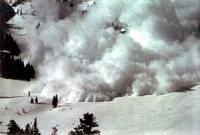-
AI to aid in humanitarian efforts
Mobile phones are one of the fastest growing technologies in the developing world with global penetration rates reaching 90 percent. However, the fact that most phones in developing countries are pre-paid means that the data lacks key information about the person carrying the phone, including gender and other demographic data, which could be useful in a crisis. Researchers have developed an AI algorithm to accurately predict the gender of pre-paid mobile phone users, so that emergency response teams would have better information about those affected by disasters.
-
-
Bomb squads to compete in annual Robot Rodeo
Robots are life-saving tools for bomb squads and emergency response teams, providing them a buffer from danger. Sandia National Laboratories is hosting the 11th annual Western National Robot Rodeo, a four-day event where civilian and military bomb squad teams get practice using robots to defuse diverse, dangerous situations.
-
-
New tool for first responders: An ice bag to the face
A new study suggests a simple bag of ice water applied to the face could help maintain adequate blood pressure in people who have suffered significant blood loss. the researchers’ aim is to help prevent cardiovascular decompensation, a sudden precipitous drop in blood pressure that limits oxygen delivery to the heart, brain, and other vital organs. Decompensation is a significant risk after blood loss, even once the person is no longer actively bleeding.
-
-
Big data study of disaster-related social media language helps first responders
Researchers explore how the properties of language style used in social media — particularly on Twitter — can help first responders quickly identify areas of need during a disaster. The researchers analyzed several hundred thousand tweets from social media users located in and around the areas where Hurricane Sandy, the Oklahoma tornadoes, and the Boston Marathon bombing occurred.
-
-
Selecting to right first responder technology
With the abundance of tools and technologies available to assist first responders, it is important to address questions such as: How do the tools perform in real-world response situations? Can they withstand uncertain environments? Are they easy to use when a responder is wearing protective gear? How heavy is the technology? Will it weigh down, or fit within the gear of a responder who is already wearing their full kit? To help first responders answer these questions so they can make informed decisions about technology acquisition, DHS Science and Technology Directorate (S&T) First Responders Group (FRG) hosted a 3-day Urban Operational Experimentation (OpEx).
-
-
Israelis, Palestinians, Jordanians jointly train to provide emergency aid during earthquakes
Working together is the name of the game in a project now underway in Israeli, Palestinian Authority and Jordanian communities. The joint project, Community Emergency Response Teams (CERT), aims to train local residents as first responders in case of an earthquake.
-
-
Emergency retweets can help in times of disaster
Twitter and other social media tools are commonly used around the world. Now, many government and not-for-profit organizations have a presence on at least one of these systems and use them in various ways to share information about their activities and engage with people. For organizations that work in disaster zones and emergency situations, these tools can also be used to coordinate activities, help raise funds and disseminate timely news that can help in relief efforts.
-
-
Predicting floods, hurricanes with social media

Social media can warn us about hurricanes, storms, and floods before they happen – according to new research. Key words and photos on social media can signal developing risks – like water levels rising before a flood. Researchers, who analyzed posts on Flickr between 2004 and 2014, found certain words – such as river, water, and landscape - take on distinct meaning of forecast and warning during time periods leading to extreme weather events. Words can be used as ‘social sensors’, to create accurate early warning system for extreme weather, alongside physical sensors.
-
-
More effective response to unpredictable disasters
When the unthinkable happens and the unpredictable takes over, crises cannot be handled by the book. Traditional emergency work emphasizes fixed procedures and strong leadership, as is typically exemplified by the police force. This approach works in most emergency situations – but not when the unthinkable happens. Evaluations of past events show that the scale of many disasters could have been reduced if local decision-making power had been greater — that is, if the part of the team that was closest to the situation had been involved in a different way.
-
-
How disaster relief efforts could be improved with game theory
The number of disasters has doubled globally since the 1980s, with the damage and losses estimated at an average $100 billion a year since the new millennium, and the number of people affected also growing. Hurricane Katrina in 2005 was the costliest natural disaster in the U.S., with estimates between $100 billion and $125 billion. The death toll of Katrina is still being debated, but we know that at least 2,000 were killed, and thousands were left homeless. Worldwide, the toll is staggering. The challenges to disaster relief organizations, including nongovernmental organizations (NGOs), are immense, and the competition among them is intense. My team and I have been looking at a novel way to improve how we respond to natural disasters. One solution might be game theory.
-
-
New avalanche, snow burial practice guidelines

With the growing popularity of backcountry snow activities, it is increasingly important to understand the best techniques for avalanche rescue. Each year, there are over 150 avalanche fatalities in the US and Europe, with most deaths occurring among recreational groups that include skiers, snowboarders, snowmobilers, and mountaineers. The Wilderness Medical Society has issued new practice guidelines to help medical professionals, as well as the public, understand the latest techniques and recommendations for avalanche risk management and rescue protocols.
-
-
A new kind of responder brings special expertise to disasters
An emergency response incident commander should be well-versed on how to respond to all hazards, including the intricacies of radiological and nuclear incidents. Because the hazards associated with radiological or nuclear (rad/nuc) incidents are uniquely challenging to convey accurately to first responders, DHS S&T has developed a solution in the form of the Radiological Operations Support Specialist (ROSS) Program.
-
-
Lawmakers want to know more about Ricin mix-up

Members of the Committee on Homeland Security sent a letter on 23 December to FEMA administrator Craig Fugate, demanding answers on how many years had first responders unknowingly trained with toxic Ricin at Anniston’s Center for Domestic Preparedness (CDP). In a three-page letter, members of the committee demanded answers for twelve questions, addressing the issue of how lethal toxin was used and the agency’s response once it found out about the mix-up.
-
-
Thermal sensor provides warning for firefighter safety
The conditions inside a burning building are perilous and can change rapidly. For firefighters searching for people trapped within a burning building, these risks can be exacerbated in a matter of seconds as exposure to high temperature may cause their personal protective equipment (PPE) to fail. This is particularly true in the presence of infrared radiation, which can rapidly increase the temperature of a firefighter’s environment without warning. DHS S&T is now working with partners to develop the Burn Saver Thermal Sensor, a battery-powered device that will be carried by firefighters and detects thermal changes in their operating environments.
-
-
New incident management planning tool for first responders
A suspicious package is found in a public park. An unattended bag is found by a trash can at the metro or a street corner. A person with a weapon is reported at a school or mall or other public location. Unfortunately, these are not uncommon occurrences, and responder agencies – from small towns to big cities – must all know how to respond and work together. That requires training, technology, tools, and time. The Department of Homeland Security Science and Technology Directorate (S&T) Explosives Division (EXD) has a solution.
-
- All
- Regional
- Water
- Biometrics
- Borders/Immig
- Business
- Cybersecurity
- Detection
- Disasters
- Government
- Infrastructure
- International
- Public health
- Public Safety
- Communication interoperabillity
- Emergency services
- Emergency medical services
- Fire
- First response
- IEDs
- Law Enforcement
- Law Enforcement Technology
- Military technology
- Nonlethal weapons
- Nuclear weapons
- Personal protection equipment
- Police
- Notification /alert systems
- Situational awareness
- Weapons systems
- Sci-Tech
- Sector Reports
- Surveillance
- Transportation
Advertising & Marketing: advertise@newswirepubs.com
Editorial: editor@newswirepubs.com
General: info@newswirepubs.com
2010-2011 © News Wire Publications, LLC News Wire Publications, LLC
220 Old Country Road | Suite 200 | Mineola | New York | 11501
Permissions and Policies
Editorial: editor@newswirepubs.com
General: info@newswirepubs.com
2010-2011 © News Wire Publications, LLC News Wire Publications, LLC
220 Old Country Road | Suite 200 | Mineola | New York | 11501
Permissions and Policies
